Learn ancient Chinese history in Shanxi, China
in 2013
(Travel Story series @ Hon Too Fang 2021)
In May 2013 we joined 15 others to tour the Province of Shanxi, north China. 15 days. This is a descriptive travel story. Some poems and idioms in Chinese are quoted, to make the story more “Chinese”. Sorry, no English translation.
The Chinese language is a very unique language. The same single word could be used as a verb or a noun or even as an adjective. And the ancient Tang poems have set rules in numbers and rhyming. For example they come in 4 phases of 5 words each or 4 phases in 7 words each. And the words in the phase have set sequence of tones, called the ping-ze 平仄rule. The beauty of a great poem is not only due to substance expressed but more on the use of the most appropriate words in the expression, in perfect rhyming, etc. In translation the meaning of the expression might be conveyed but the beauty in the words and rhyming are lost. The translated piece becomes an ordinary prose, rather than an extra-ordinary poem.
Where is Shanxi 山西 ?
Shanxi is west of Beijing 北京, the capital of China, and east of Shaanxi 陕西, home of Xian 西安 and the terracotta warriors. Got it? No? Then look at this map! By the way to the south is Henan 河南and to the immediate east is Hebei 河北.
Why Shanxi?
Because it is there! Need to explain why meh?
Shanxi Info
Shanxi is a province about 157,000 sq km in size (half of Malaysia) with a population of 36 million. The capital is Taiyuan 太原 with 4.2 million people. The largest city is Yuncheng 运城 with 5.1 million people. Then there is Datong 大同, the coal capital of China, with a population of 3.3 million. But it is a rather poor state, mountainous and not having much rainfall. See the pathetic "skinny" newly-sheared sheep found along a country road near Datong, and a common scene of the country side. Shown coal pellets used for domestic consumption, only allowed in rural areas. The province is also famous for its mature black vinegar or 山西老陈醋,1 of 4 top vinegars in the country, and it is very tasty.
Tourist attractions
Shanxi is located in the cradle of the ancient Chinese civilisation. The great Yellow River or Huanghe 黄河 flows through it. So in tourism it sells history, history older than Shaanxi and the terracotta warriors.
三千年历史看陕西, 五千年历史看山西.
There are 4 UNESCO World Heritage sites visited. We also visited several border towns in the neighbouring provinces of Henan 河南 and Hebei 河北.
(Part A) The secondary attractions
The main attraction is ancient history and culture of course. I would present the secondary attractions first before the main ones.
(A1) Engineering wonder: the Kaiyuan Iron Ox 开元铁牛
One of the famous ancient crossing point along the Yellow River is Pujindu
蒲津渡 in south-west Shanxi. The old crossing was a pontoon bridge, secured to the river banks via anchor blocks. On each side of the banks 4 giant iron oxen were cast as the anchor blocks. They were cast in 725 AD during the Song Dynasty 宋朝 (Chinese calendar: Kaiyuan 13, 开元十三年). Each ox is about 1.5 m tall, 3.3 m long and weighs 30 tonnes. Below each ox are base plates and raking poles (like modern rake piles for bridges) weighing a further 40 tonnes. Beside each ox was an iron man. But not the Hollywood version. The crossing point was abandoned about 500 years later. The oxen were unearthed in 1989.
(A2) Engineering wonder: the Red Flag Canal 红旗渠
The city of Linzhou 林州 in the northern part of the province of Henan has long suffered from annual drought. Between 1960 and 1970, the local people engineered an irrigation canal system to bring water to their city from a river located in Shanxi Province. The main canal is 70 km long, 8 m wide and 4.3 m deep. The total length of distributive canals constructed is 1,500 km.
The wonder of the project lies in the difficult condition the people had to work, and the lack of modern machinery. Most parts of the main canal were built along the cliff face of high mountains. 211 tunnels were blasted through. Workers just used picks and chisels to clear away blasted rock fragments, shown by the 1st photo, a shot of the original photo at the museum. The 2nd photo shows spitting of the main canal into 2 near the museum building.
We went to look at a section of the main canal, called Youth Cave 青年洞. At this point the canal was about 30 m above the base of the cliff and 60 m below the top of the cliff.
And what were the Americans doing in the 1960s? Neil Armstrong landed on the Moon in 1969. See how backward China was then. And see how much China has developed since then.
(A3) Scenic spot: Yuntaishan 云台山
This piece of info may surprise many of you: the most visited scenic spot in China is not Jiuzhaigou 九寨沟 or Zhangjiajie 张家界 or Huangshan 黄山, but this Yuntaishan 云台山 in north-west Henan Province. Is the scenery so extraordinary? No, it is just people power. Huge ready consumer market. Yuntaishan is located in the populous Henan Province and close to populous provinces of Hebei and Shanxi. Plus a lot of over-hyped advertisement.
集 泉、瀑、溪、潭、涧 诸景于一谷,融 雄、险、奇、幽、秀 诸美于一体.
Blah blah blah blah blah blah.
It is the first Chinese Global Geopark recognised by UNESCO. A huge scenic region: 190 sq km in size, or 80% of Kuala Lumpur, with over 230 eco-friendly buses to ferry tourists. We were here a full day, walked more than 10 km and toured parts of 3 scenic areas.
Hongshixia 红石峡
First at Hongshixia 红石峡 or Red Rock Gorge, a gorge with red quartzite sandstone, a typical Chinese danxia landform. The red colour is due to the rich presence of iron in the rock. The gorge is about 1.5 km long.
Quanpuxia 泉瀑峡
Next at another gorge called Quanpuxia 泉瀑峡 or the Waterfall Gorge. The 1st photo shows the cliff face at the waterfall location. In rainy days the waterfall from the top is 314 m high, said to be the highest in China. But we found no water there. The park workers said the waterfall would form only after 3 continuous days of rain. An over-hyped scenic spot. In China every tourist spot is over-hyped! World No 1 天下第一, Top 4 in China 中国四大,
blah blah blah blah blah blah…..
Scenes along the main river
(A4) The mansions of the rich and powerful
During the late Ming Dynasty 明朝 (1368 – 1644) and Qing Dynasty
清朝 (1644 – 1912) there were many successful Shanxi businessmen and court officials. We visited a few of their famous residential complexes, a legacy of these rich and powerful: the Chang Mansion 常家莊園, the Qiao Mansion 乔家大院, Wang Mansion 王家大院 and Premier's Residence 皇城相府. Each one has hundreds of buildings, complete with outer walls and huge gardens, and decorated with wood carving, brick carving and stone carving.
Premier's Residence 皇城相府
This Premier's Residence 皇城相府 is the mansion completed within the shortest time among the 4. It was constructed between 1632 and 1703, with 16 courts, 640 buildings. Bigger than our Sri Perdana for sure. The builder was one Chen Yan Jing 陈廷敬, a top court official during the Qing Dynasty with powers equivalent to a present-day prime minister. The 1st 4 photos show the outer wall and the entrance gates.
Wonder why no anti-corruption agency to investigate his wealth then.
The next 2 photos are views on the roof, then the premier’s private residence, one of the many gardens, and samples of the brick carvings.
Chang Mansion 常家莊園
The biggest of the other 3 mansions, all built by commoners, is the Chang Mansion 常家莊園. The Chang clan were business people. They became a prosperous clan around the mid-18th century and started their massive building work, for about 150 years. At the peak it has over 1,500 buildings and 13 gardens. The part open to the public now is just a small portion.
Being a residential complex of a commoner clan, there is no high external walls or impressive gates to boost. But they have impressive gardens, carved wall panels and intricate carved timber door and window frames. First the viewing pavilion and 2 lakes in the Ginkgo Garden.
In the study area many of the walls are decorated with carved wordings of famous poems, words of wisdom, etc. In fact the clan is famous for their scholarship and has produced many high ranking court officials over the many generations.
Their ancestor memorial hall, built in 1882, is said to be the most well-preserved in China.
Wang Mansion王家大院
The Wang Mansion is an accumulation of construction since the mid-1600s, near the start of the Qing Dynasty. It encompasses some 120 groups and 1,120 buildings. There are 2 main sections. We went to one section called Gaojiaya 高家崖. Show the main gate, buildings and a garden.
This mansion is famous for its intricate timber carvings, like in window frames.
Qiao Mansion 乔家大院
Qiao Mansion 乔家大院is the smallest of the mansions we visited, with 6 big courts and about 330 buildings. It is the residence of the Qiao clan represented by the financier Qiao Zhiyong 乔致庸 (1818 - 1907). Construction began in 1756 and continued up to the early 20th century. It is famous for being the main filming location of the movie “Raise the Red Lantern 大红灯笼高高挂” starring Gongli 巩俐and directed by Zhang Yimou 张艺谋.
Shown buildings with some emphasis on the red lanterns. The last photo shows one of the 2 lanterns called “9-dragon lantern” gifted by Empress Dowager Cixi 慈禧太后to the clan, a reward for “patriotic donation”.
(A5) The first bank in China in Pingyao Ancient City 平遥古城
Pingyao is one of the 4 most well-kept ancient cities in China, located at the central part of Shanxi province. It is a UNESCO World Heritage Site. Here most of the 4,000 buildings date back to the Ming and Qing Dynasties, several hundred years old. Shown part of the restored city walls and one of the original watch towers.
The main street is South Street 南街. Most of the buildings are used for commercial purposes: café, small hotels, souvenir shops, etc.
One of the buildings is the original premise of Rishengchang 日昇昌, reputed as the first commercial bank in China, founded in 1824. They were the first enterprise to issue some kind of "travellers' cheques" which could be cashed in their offices in other cities. At the peak it had branches in over 30 cities, including offices in Europe.
Shown a "cheque" and the VVIP Infinity Card customer lounge for one to enjoy his opium puff. You would be amazed at the security features of these early cheques. They included: using paper made of 3 layers with secret marking in the middle layer, using different calligraphic styles for different days or periods, encrypting the date and amount, and lastly the counterfoils were delivered to the other offices by special trusted couriers.
(A6) Mianshan 绵山
Mianshan is a mountain range in the central part of the Shanxi province famous for scenery. We were here a full day, visited a few scenic zones. It was a gloomy day with on-and-off drizzles. Poor vision due to the mist and thus poor photo quality in terms of clarity.
Mianshan is very much associated with this man Jie Zitui 介子推. Legend says he was a Taoist follower, a high-ranking court official in the Spring-Autumn era, or 600s BC. He retired to live with his mother in Mianshan to pursue his Taoist ideals. However the emperor wanted him to continue working and tried to force him out of retirement by burning the mountain. Instead he and his mother were burned to death. He has since been deified and his statue is everywhere.
Daluogong 大罗宫
This is a group of Taoist temples dated to 2,000 years ago, greatly expanded under a decree of an emperor of the Tang Dynasty in 732. They were built along the cliff face. The present buildings date to the late 1990s.
Due to the bad weather outdoor shots are poor and only is shown. The faint horizontal line on the top part of the 1st photo shows the Heaven Bridge 天桥which is a 300 m long walkway up the cliff. We did go up there. Other shots are decorations of the temples.
Baofu Temple 抱腹寺
The word “baofu” means “settled in the stomach or the middle section” so Baofu Si means the temple settled in the middle (of a cave). The history dates back to about 1,700 years ago. The cave is about 60 m high, 50 m deep and 180 m long with some 200 buildings. It started off as a Buddhist temple but now houses both Buddhist and Taoist institutions.
Weather was slightly better but still misty.
One special practice here is the fixing of wishing bells onto the cliff face commissioned by the devotees. Specialist workers would hang on long ropes and swing down from the top of the cliff to fix these bells. The top row of black-n-red spots in the 2nd photo are wishing bells.
Shuitao Gou 水涛沟
We also spent some time at this park.
(A7) Guanque Pavilion 观雀楼
This is one of the most famous pavilions dated to ancient times. The original was built during the Northern Zhou 北周 period, 557-580 AD. It is located at the ancient city of Puzhou in Shanxi and near to the borders with Shaanxi and Henan provinces. It has been graced by many poets over 600 years until it was destroyed by armies of Genghis Khan in 1222. The most famous poem about the pavilion is "登观雀楼" penned around 704 by one 王之涣
白日依山尽,黄河入海流。欲穷千里目,更上一层楼
A poem familiar to Chinese primary school students.
The present building was completed in 2002. It is 6-storey high, of typical Tang architecture. Still a misty/hazy day of poor photography. Shown balloons at the entrance gate, the pavilion and some details, a postal stamp featuring the building and a calligraphic exhibit inside the pavilion.
(A8) Hukou Waterfall 壶口瀑布
This is the largest waterfall on the great Huanghe 黄河 or Yellow River, located at the boundary between the provinces of Shanxi and Shaanxi. It is also the 2nd largest waterfall in China. The width is about 30 m and the fall up to 50 m. Of course the "impressiveness" of a waterfall depends very much on the amount of water flow and hence the weather. At the time of our visit, just average flow and it is thus unimpressive or we were unimpressed.
(A9) Wuling Congtai 武灵丛台
This is one of the country's famous ancient parks/gardens. It is located in the old city of Handan 邯郸 in southern Hebei province. During the time of the Warring Period, Emperor Wuling 赵国武灵王 from the Zhao Dynasty (325 - 299 BC) inspected his troops here on a series of elevated platforms, hence the name. "Congtai" means a series of platforms. The present buildings are dated to the early Qing Dynasty and represent a small part of the original. It is more like a park now. Shown part of the main inspection platform and history being told in ceramic tiles and a giant painting.
(A10) Shrine of Saint Lu吕仙祠
This shrine located in the city of Nandan 邯郸in Hebei Province is one of the most well know Taoist shrines in northern China. It was founded in the Song Dynasty (960 – 1279). Lu Dongbin 吕洞宾 is a legendary Taoist character, one of the 8 who are collectively known as “The 8 Saints”.
He is said to be a scholar trying very hard to do well in the court exam so that he could became a court official. One day he felt asleep and had a long vivid dream where he did do well in the exam, became powerful and rich, had a family, enjoyed a full life and finally died. When he woke up he realised that life is only transient. He gave up the hard pursue and became a Taoist follower. The story is termed as 黄粱美梦, a well-known phase, and this is the theme in the design of this temple.
Shown the entrance gate, the courtyard, the main hall and statues of the saint, and carving and things about the dream of 黄粱美梦.






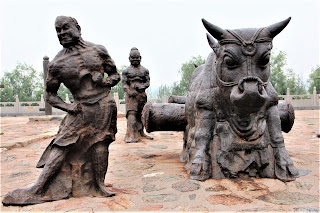



































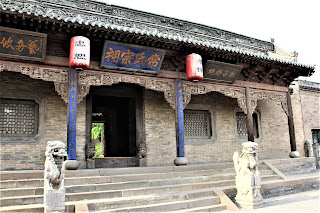































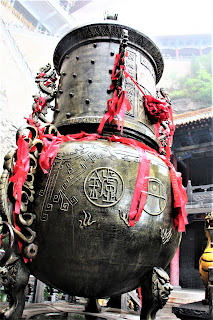






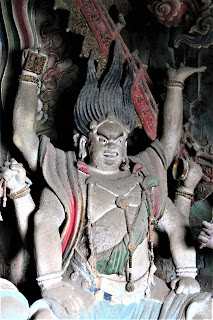

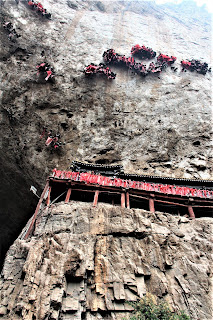


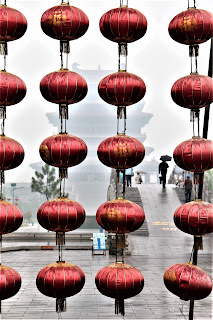








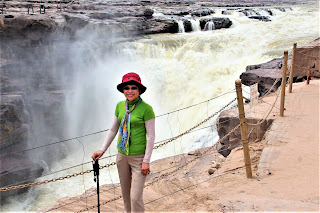












No comments:
Post a Comment